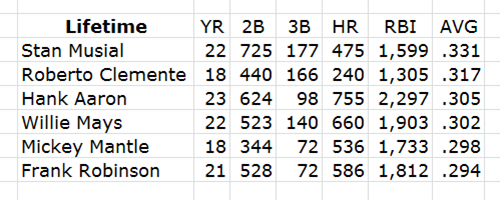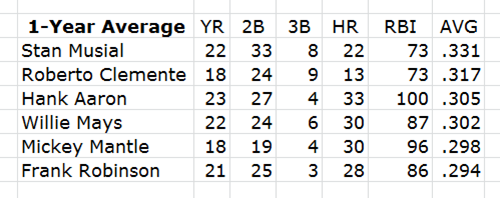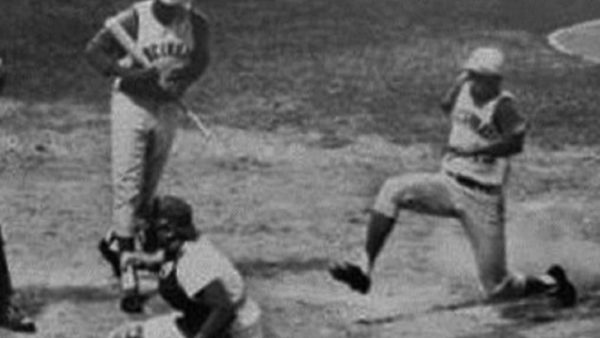I confess. I’m guilty.
No, that’s not Tom Brady talking – although Brady should be talking and doing a mea culpa instead of lying through his proverbial teeth. That’s me doing the talking and admitting that I was wrong about the best baseball players I ever saw.
Up until today, when asked that question, the names flew from my lips:
• Willie Mays
• Roberto Clemente
• Frank Robinson
• Hank Aaron
Curiously, the name of Mickey Mantle never came to mind – nor did the name of the player who just might’ve been better than all those other guys. I’m talking about Stan Musial – Stan the Man.
 Stanisław Franciszek Musial was born in Donora, Pennsylvania – the fifth child of European immigrants – his father from Poland and his mother from Carpatho-Rusyn. His father always called him Stashu – as did my father – who was both a baseball fan and also the son of Polish immigrants.
Stanisław Franciszek Musial was born in Donora, Pennsylvania – the fifth child of European immigrants – his father from Poland and his mother from Carpatho-Rusyn. His father always called him Stashu – as did my father – who was both a baseball fan and also the son of Polish immigrants.
So Stashu Musial was my dad’s favorite ballplayer – but not mine. In retrospect, I’m guessing it was because Stan the Man just wasn’t as sexy as those other guys. Stan Musial never made basket catches or had his hat fly off when he swung and missed or was all arms and legs when he ran the bases. In fact, Stan Musial never did anything on the baseball field with any flair. But as I just confirmed for myself, Stan the Man Musial did everything on the baseball field – and did everything quite well.
Fifty-seven years ago today, the St. Louis Cardinals were playing a day game against the Chicago Cubs at Wrigley Field. Musial – who was leading the league in batting with a .483 average – was taking the day off. Sitting on the bench was foreign to Musial. Five times during his 22-year career in the big leagues he played every game on the schedule. But he was nursing a strained thigh that day.
The game moved into the top of the sixth with the Cubs on top 3-1 behind the four-hit pitching of Moe Drabowsky. “Toothpick Sam” Jones was pitching for the Cards. Toothpick Sam had a devastating curveball that you could see on TV. Please note – there were only two or three cameras televising games back then and none were behind the pitcher’s mound or behind home plate. Our TV coverage was primitive, but you could see his curveball break on our 12-inch, black-and-white screens from a foot behind a right-handed batter to knee-high on the outside corner.
A year later, Jones was traded to the Giants and won 21 games with a 2.83 ERA and four shutouts. But getting back to the top of the sixth:
Cards right-fielder Gene Green led off with a double to right. Catcher Hal Smith hit a ground ball to short. Ernie Banks fielded the grounder, checked Green back toward second, and then threw Smith out at first for out number-one.
Sam Jones was walking toward the plate to take his turn at bat. But wheels were turning inside the brain of Cards manager Fred Hutchinson.
• One: Hutchinson made a quick call to the bullpen to get Billy Muffett warming up.
• Two: He called Sam Jones back to the dugout.
• Three: He sent Stan Musial up to pinch-hit for Jones.
Musial delivered with a gapper to left-center that scored Green and cut the deficit to 3-2. That was Stan Musial’s 3,000th hit.
Hutchinson sent Frank Barnes in to pinch-run for Musial and Barnes scored the tying run when Don Blasingame followed with a single. By the time the inning ended, the Cards were on top 4-3 and went on to win 5-3.
Prior to that day – May 13, 1958 – only seven players had accumulated 3,000 hits. Musial was the eighth. Since then, another twenty players have notched 3,000 hits. Pete Rose tops the list with 4,256 hits and Roberto Clemente bottoms the list with exactly 3,000 hits. Musial ranks fourth with 3,630 hits.
So I dug into the lifetime stats of Stan Musial and compared him with Mays, Clemente, Robinson, Aaron, and Mantle – and I was shocked. I compared them in regard to doubles, triples, home runs, RBIs, and batting average – and created two charts. One listed the career numbers and the other listed those numbers divided by the number of years each played to simulate an average season.
Aaron played for 23 years. Musial and Mays both played for 22 years – although both missed one full season to serve in the military. Robinson played for 21 years. Clemente and Mantle both played for 18 years.
First the lifetime numbers.
And those lifetime numbers extrapolated to simulate an average season.
During his career, Stan Musial led the league in the following departments:
• Hits – 6 times.
• Runs – 5 times.
• Doubles – 7 times.
• Triples – 5 times.
• Home runs – never – highest total 39 in 1948.
• RBIs – twice.
• Batting Average – 7 times – highest .376 in 1948.
• OBP – 6 times – highest .450 in 1948.
• Walks – once.
Stan Musial was the MVP of the National League three times, played on three World Series champions, and was named to the All-Star team 24 times.
Somehow, I was blinded by flash and dash. I overlooked and under-rated one of the greatest players of all time – Stashu – Stan the Man Musial.
Barry Bowe is the author of Born to Be Wild, 1964 – The Year the Phillies Blew the Pennant, and 12 Best Eagles QBs.









Comments
No Comments